Sous Vide Salmon – PolyScience Sous Vide Professional
Our salmon was excellent! Once again, it was perfectly cooked throughout. We like our salmon slightly undercooked, so we chose a temperature of 138.5 degrees Fahrenheit and added some fresh dill and lemon to the bag that was immersed in the sous vide bath. Add a nice sear when done and you have wonderfully flavored and perfectly cooked salmon.
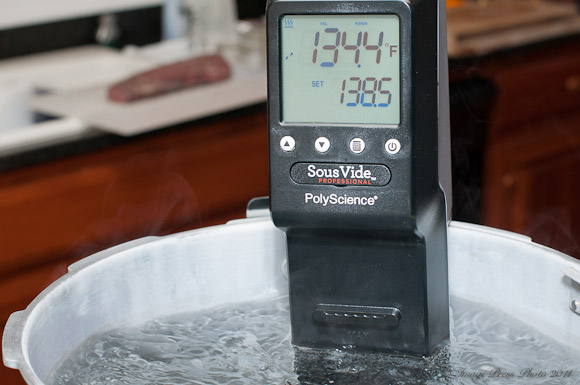
The temperature for the salmon needs to be 138.5 degrees Fahrenheit
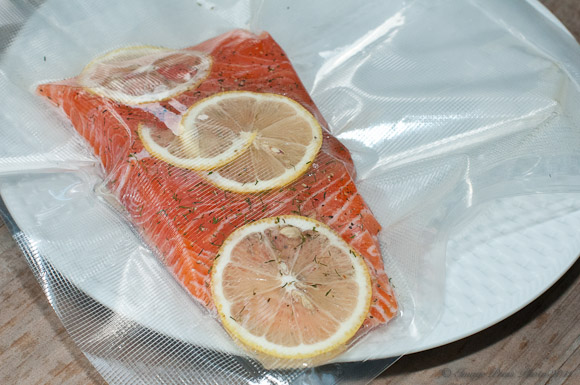
Cryovac the salmon fillets with the dill, butter and lemon
On the other hand, our scallops were not perfect. The flavors with the lemon and thyme were excellent, but we learned a lesson about vacuum sealing. If you apply too much of a vacuum seal, you will crush a soft meat or muscle, like scallops, and they become compressed and too firm. We will know better next time.
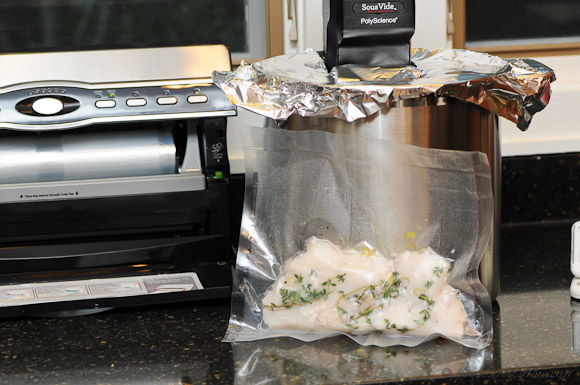
Extra care needs to be taken when cooking scallops
Fish requires 10-15 minutes to cook in the sous vide. Meat is typically done in 30-45 minutes. Vegetables, like carrots, can take 45 minutes to an hour to cook. We chose carrots as our initial vegetable. Once again they were perfectly cooked, however, I can’t say we loved the recipe. We tried cumin with the carrot, as suggested in the cookbook, but I would use some other herbs and season them differently next time.
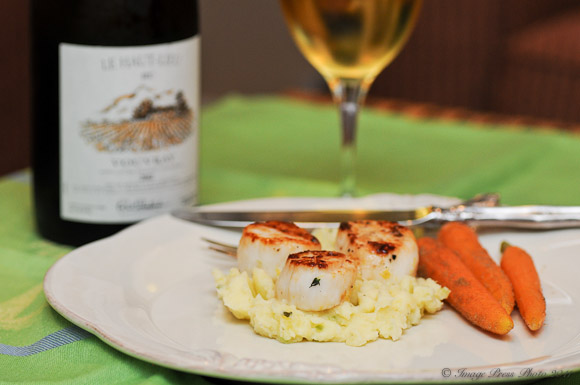
We prepared the scallops and the carrots in the same evening
This brings me to one of our favorite surprises, eggs. You can have the ultimate egg with sous vide! Cooked exactly like you want it. We chose 75 degrees Centigrade. The white almost had a creamy texture and the yolk was done but not overdone. There was no telltale overcooking that shows up as that green/blue ring between the yolk and the white. For recipes that require eggs cooked to a certain doneness (from very soft to firm), sous vide makes it easy and you can do it ahead of time.
The other major benefit of sous vide is that the cooking time is less precise. It reaches a certain temperature as controlled by the sous vide processor and then it stays at that temperature, regardless of how long you cook it. Imagine leaving a Chateaubriand (that you spent major bucks on) in the oven for an extra 20 minutes. Not a good thing. With sous vide, if it is done in one hour, it is essentially the same doneness in 2 hours.
Better yet, allowing the food to cook longer in the water bath makes it more tender. The water bath breaks down collegans and the longer it stays in the bath, the more the collegens are broken down and the more tender the meat. Our tenderloin could be cut with a fork.
I will say that the longer it cooks beyond the recommended time you will lose internal juices. So, while the meat may be tender it is not as juicy if left in the water bath too long. A tenderloin that is cooked 45 minutes to an hour is far juicer than one that is cooked for 4 hours. This is something you need to perfect over time.
To me, the major advantage of sous vide is that I can prepare for parties ahead of time and that I don’t have the same big messy kitchen afterward. For certain dishes, sous vide can’t be beat for perfect preparation. The salmon was just the way we like it. The tenderloin melted in your mouth. When you saute it in a pan and then perhaps, finish it in the oven, it is more difficult to find that perfectly cooked meat.
If you entertain often or are as fussy as we are about the preparation of your food, or you like to prepare dishes ahead of time, you may also be interested in trying the sous vide method. We have a long list of dishes that we plan to try. Next up is lamb chops, so stay tuned!
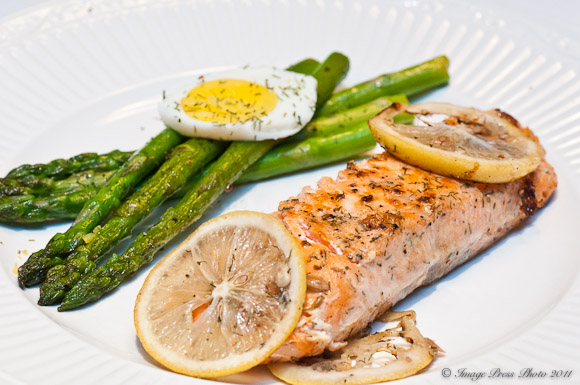
The fish was beautiful and perfectly prepared. Notice the perfect preparation of the egg.
Have a great weekend!
Disclosure – Polyscience has provided the Sous Vide Professional for our review.
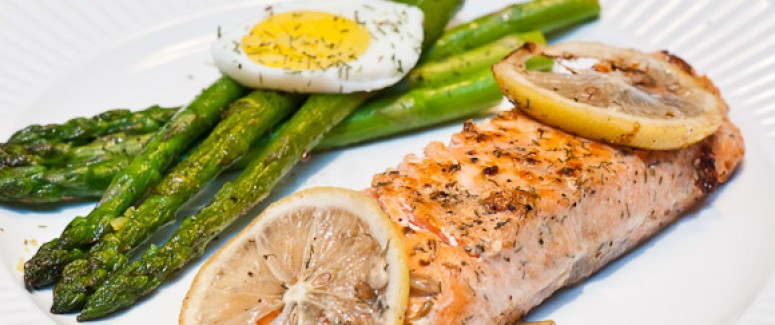
Sous Vide Salmon
Ingredients:
3-6 oz. fresh Wild-Caught Salmon Fillets
Freshly ground Sea Salt
Freshly ground black pepper
3 fresh dill sprigs, snipped
3 Tablespoons unsalted butter (1 Tablespoon per fillet)
1/2 fresh lemon, sliced thinly
1/2 fresh lemon, juiced
Directions:
Season the salmon with olive oil and a sprinkling of salt and pepper. Apply freshly squeezed lemon to each fillet and 1-2 thin slices of lemon to each side of the fillets. Sprinkle snipped, fresh dill over each fillet.
Place each fillet in a separate cryovac bag. Add the butter (While there are special vacuum sealers for Sous Vide, most home cooks can use a traditional vacuum sealer like Foodsaver or Seal-a Meal).
Vacuum seal the bag to 60% vacuum. You will want as much air out of the bag without drawing so much air that it compresses the fish. The key is to eliminate air pockets so the fish is in direct contact with the bag without compressing the fish.
Bring your immersion Sous Vide to 120 (rare) to 125 degrees (medium rate) Fahrenheit. Meanwhile your fish will marinate.
Place the bag in the immersion tank and allow to circulate in the hot water bath for 12-20 minutes depending on the thickness of your fillet. Remember, you won’t overcook the fish with the longer temperature but you will lose moisture.
When the fish is cooked, remove the bag from the pot and take the fillets out of the bag. (You can double-check the temperature by inserting the thermometer directly into the fish.)
Heat olive oil in a saute pan on high heat until almost smoking. Place the fillets in the pan, presentation side up, for about 1 minute to create a golden crust.
Remove from the pan and serve immediately.
Our experience shows us that you have to experiment with a recipe to get the temperature the way you like it.










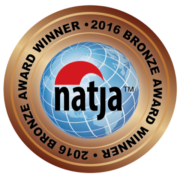





Gwen,
Thank you for this marvelous post! The pictures are mouthwatering as always! Steven H left M with Brad and opened a fabulous fried chicken restaurant down the road called Buttermilk where they do the Springer mountain chicken sous vide and then do the quick fry to seal in the bread mixture. Unbelievable how sous vide makes food taste so succulent and locks in the flavor. That gadget is on my most wanted list now! Keep up your fantastic work. It remains a highlight in my inbox!
Hi Maria,
Thank you for your nice comment. 🙂 Sorry to hear about all of the changes going on in your part of the state. However, that is great news for Steven and Brad and we will definitely have to get up that way this fall for some awesome fried chicken!!
Gwen
I love Sous Vide, specially beef! It’s such a delicate way to prepare dishes…Although I’ve never done it at home, this must be quite fun! Your dishes look gorgeous and delcious Gwen!
That is completely new info for me.
Fascinating!
Had never heard of it, but enjoyed learning about this, Gwen.
Great article and photos!
Sous Vide is on my food-adventure list, thanks for outlining a variety of dishes here to inspire the plunge! 🙂
Wow… what gorgeous pictures! I had heard about sous-vide, but I had no idea that it would work so well with so many different kinds of protein. I especially love the look of that salmon!
Your salmon looks absolutely phenomenal. And the tenderloin looks just as delicious. Now I’m going to be wanting a sous vide even more than I was before!
I went to a sous vide demonstration at Williams Sonoma. I really didn’t give it a second thought as far as purchasing one, but they didn’t really emphasize the ready when you are and less mess in the kitchen selling points! Might be worth the $$. Great post, Gwen!
Does anyone have thoughts on the following: Being a busy parent of 3 kids, I’d like to prepare food (steaks, cutlets, etc), vacuum seal them and then freeze. Can I then place the frozen packets in the sous vide for cooking? Naturally at a somewhat longer cooking time.
Nick
There is no problem preparing your individual meals and freezing them uncooked. I would recommend removing the meal from the freezer and defrosting it in the refrigerator rather than going directly to the sous vide hot bath. Freezing will prevent the growth of any anaerobic bacteria from growing. The proteins will cook better when thawed. You can keep most vacuum packed meats in the freezer from 2 months (fish) to 6 months (beef). Longer periods tend to impact the quality of the protein. I also suggest placing the sous-vide pouches in an outside container or zip bag to further protect from freezer burn.
When you defrost your sous-vide bag in the refrigerator it is critical to use it the next day. DO NOT leave the thawed bag in the refrigerator for more than 24 hours (though the experts say 48 hours) for the same reasons as mentioned in the following paragraph.
One BIG CAUTION. Never store your sous-vide cooked food in vacuum sealed bags in the refrigerator for an extended period of time. Depending on the temperature of your refrigerator, you run the risk of anaerobic bacteria (botulism) growing and Sous-vide temperature are often time insufficient to kill the bacteria in the cooking process.
Here are a couple of articles. http://www.ncbi.nlm.nih.gov/pmc/articles/PMC91810/
and
http://www.chicagofoodies.com/2007/07/sous-vide-from-.html
Mr B, I appreciate the advice. I was originally thinking of purchasing a SousVide Supreme but now I’m leaning towards the PolyScience unit. I believe it will give me more flexibility with container size and also with roasts and such.
The PolyScience unit provides far more flexibility and it is easier to store. You can use a stock pot, Lexan tub or container appropriate in size for what you are cooking and we have even prepared different ingredients at the same time under the same temperature in larger containers. We had considered the Supreme but decided on the PolyScience unit just for the reasons you have mentioned.
Another Sous-vide article will be coming soon. We take a look at the impact of different cooking times on different proteins.
Question:
I’ve read recipes saying to cook meat for 30 hours, but this article says “Fish requires 10-15 minutes to cook in the sous vide. Meat is typically done in 30-45 minutes. Vegetables, like carrots, can take 45 minutes to an hour to cook.” Do I miss something?